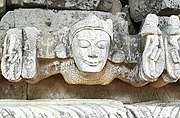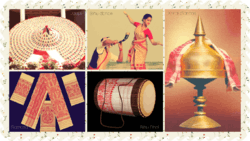Davaka
Davaka was a kingdom of ancient Indian subcontinent, located in current central region of Assam state.[4] The references to it comes from the 4th century Allahabad pillar inscription of Samudragupta, where it is mentioned as one of five frontier kingdoms of the Gupta Empire; the Shung-Shu History of the Liu Song dynasty, where the kingdom is named Kapili (now the name of a river); the Gachtal stone pillar inscription written in Kamrupi Prakrit.[5][6] N K Bhattasali has identified it with Dabaka in modern Nagaon district, with the kingdom associated with the Kopili-Kolong river valley.[7][8]
Davaka Kingdom | |
|---|---|
| ??–6th century CE | |
| Capital | Unknown and Lang-kha or Lanka (at the time of Bhoum Pal Barahi) |
| Historical era | Classical Period |
• Established | ?? |
• Disestablished | 6th century CE |
| Today part of | |
| Part of a series on the |
| History of Assam |
|---|
 |
|
Proto-historic |
|
Late Medieval |
|
Modern |
|
Contemporary |
| Categories |
|
| Part of a series on the |
| Culture of Assam |
|---|
 |
|
Proto-historic
Classical Medieval
Modern |
|
|
|
Festivals
|
|
Religion Major
Others |
|
History
Archives
Genres
Institutions
Awards
|
|
Music and performing arts |
|
Media |
|
Symbols
|
In 4th-century Davaka was mentioned as frontier kingdom with Kamarupa in the Samudragupta's Prayaga stone inscription, which was later absorbed by 6th or 7th century by western kingdom of Kamarupa,[9] though later historians like B N Puri (1968) and P C Choudhury (1959) claim that it was absorbed much earlier in the first half of the 5th century during the reign of Kalyana Varman (422-446).[10][11][12]
Its capital was located near Kapili river. In the year 428 A.D, an embassy was sent to China by Davaka king, whose name according to Chinese sources is Yuegnai or Yu Chai.[13]
References
- "639 Identifier Documentation: aho – ISO 639-3". SIL International (formerly known as the Summer Institute of Linguistics). SIL International. Retrieved 29 June 2019.
Ahom [aho]
- "Population by Religious Communities". Census India – 2001. Ministry of Home Affairs, Government of India. Retrieved 1 July 2019.
Census Data Finder/C Series/Population by Religious Communities
- "Population by religion community – 2011". Census of India, 2011. The Registrar General & Census Commissioner, India. Archived from the original on 25 August 2015.
- Suresh Kant Sharma, Usha Sharma (2005), Discovery of North-East India: Geography, History, Culture, ..., Davaka (Nowgong) and Kamarupa as separate and submissive friendly kingdoms
- Indian History Congress (2002), Proceedings - Indian History Congress - Volume 62, p. 136 identified with the Davaka region of Nagaon district of Assam, the location of which, can be confirmed by the Gachtal stone pillar inscription.6 The Allahabad stone pillar inscription of Samudragupta mentions Davaka along with Samatata
- Kamrupi inscriptions associated with the Kamarupa kingdom give an estimate of its geographical location and extent.(Lahiri 1991:26–28)
- (Mookerji 1973, p. 24)
- (Dutta 208:53)
- Kanak Lal Barua (1933), Early history of Kāmarupa], Page 47 "in the sixth or the seventh century this kingdom of Davaka was absorbed by Kamarupa."
- "As regards the eastern limits of the kingdom, Davaka was absorbed within Kamarupa under Kalyanavarman and the outlying regions were brought under subjugation by Mahendravarman." (Choudhury 1959, p. 47)
- "It is presumed that (Kalyana Varman) conquered Davaka, incorporating it within the kingdom of Kamarupa" (Puri 1968, p. 11)
- In the middle of the 6th century A.D. the Davaka kingdom had been annexed into the kingdom of Kamarupa and probably it was turned into a visaya (district) under the administration of Kamarupa making Davaka its headquarters
- Indian History Congress (2002), Proceedings - Indian History Congress - Volume 62, p.138 Davaka region into the Kamarupa kingdom. Besides these, the Chinese source clearly mentioned that the mission was sent by a king called Yueh-ai of the Kapili state whose capital city lies close to the Heng-ho or Ka- pi-li-ho river.
Bibliography
- Choudhury, P. C. (1959). The History of Civilization of the People of Assam to the Twelfth Century AD. Department of History and Antiquarian Studies, Gauhati, Assam.CS1 maint: ref=harv (link)
- Dutta, Anima (2008). Political geography of Pragjyotisa Kamarupa (Ph.D.). Gauhati University.
- Puri, Brij Nath (1968). Studies in Early History and Administration in Assam. Gauhati University.CS1 maint: ref=harv (link)
- Mookerji, Radhakumud (1973). The Gupta Empire. Motilal Banarasidass.CS1 maint: ref=harv (link)
- Sharma, M M (1990), "Language and Literature", in Barpujari, H K (ed.), The Comprehensive History of Assam, I, Guwahati: Publication Board, Assam, pp. 263–264CS1 maint: ref=harv (link)